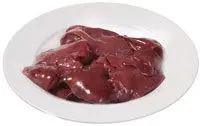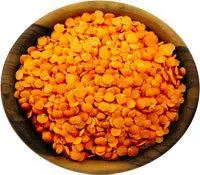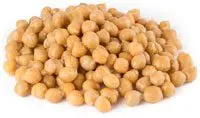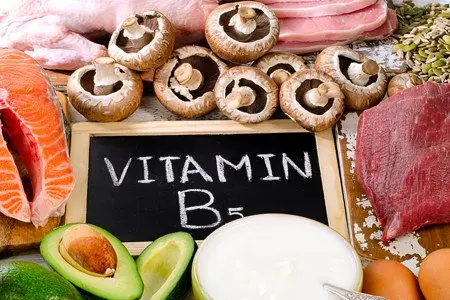Contents


Pantothenic acid (also known as vitamin B5) is an essential vitamin for normal human life. He takes part in hematopoiesis, the conversion of food into energy.
Pantothenic acid is a water-soluble substance necessary for the production of its own coenzyme A (CoA), an acyl carrier protein (CoA). The latter plays an important role in the synthesis and absorption of fatty acids. [1].
The production of its own pantothenic acid is one of the functions of the intestinal microflora. However, to date, it is not completely known whether it affects the overall absorption of vitamin B5 by the body. [2].
Products-record holders for the content of vitamin B5
Approximately 85% of dietary vitamin B5 is in the form of CoA and phosphopantetheine. Valuable pantothenic acid is found in a variety of products of plant and animal origin. The highest concentration of vitamin B5 contains organ meats, shiitake mushrooms, sunflower seeds.
 Dry: 21,9 mg
Dry: 21,9 mg Chicken: 8,3 mg Beef: 7,1 mg Turkey, goose, duck: 6,2 mg Pork: 4,8 mg
Chicken: 8,3 mg Beef: 7,1 mg Turkey, goose, duck: 6,2 mg Pork: 4,8 mg 7,2 mg
7,2 mg 2,2 mg
2,2 mg Dry: 2,1 mg Boiled: 0,6 mg
Dry: 2,1 mg Boiled: 0,6 mg 2,0 mg
2,0 mg Baked: 2,0 mg
Baked: 2,0 mg Fried: 1,7 mg
Fried: 1,7 mg 1,7 mg
1,7 mg Dry: 1,6 mg Boiled: 0,3 mg
Dry: 1,6 mg Boiled: 0,3 mg+ 10 more popular foods rich in vitamin B5 (mg) | |||
Champignon | 1,5 | Buckwheat | 1,2 |
Avocado | 1,4 | Cashew | 1,2 |
Veal, pork | 1,4 | Chicken | 1,2 |
Rice, oatmeal | 1,3 | Peanut | 1,0 |
Mink, grayling, mackerel | 1,2 | Turkey | 0,9 |
View the entire table of herbal products 300+ ➤
View the entire table of animal products 150+ ➤
Daily intake of vitamin B5 for women, men and children
The norm of vitamin B5 is 5,0 mg for adult men and women.
Categories of people | Daily requirement, mg |
0-3 months | 1,0 |
0-6 months | 1,5 |
7-12 months | 2,0 |
1-3 years | 2,5 |
3-11 years | 3,0 |
11-14 years | 3,5 |
Men 14 and older | 5,0 |
Women 14-18 years old | 4,0 |
Women aged 19 and over | 5,0 |
Pregnancy | 6,0 |
Lactation | 7,0 |
Norms of physiological requirements for vitamins in the Russian Federation (RF, MR 2.3.1.2432-08)
Why do we need vitamin B5?

Without vitamin B5, it is impossible to imagine a number of important physiological processes:
Transformation of food into glucose.
Cholesterol production.
Synthesis of hormones that affect sexual activity, stress resistance.
Formation of erythrocytes.
The action of pantothenic acid protects the digestive organs. Without it, the body cannot fully absorb other vitamin compounds, especially vitamin B2.
Pantothenic acid, along with other B vitamins, is involved in the breakdown and absorption of fats, proteins, carbohydrates. Assimilated elements are processed into energy, contribute to the renewal of muscle fibers, internal organs and tissues.
Coenzyme A
Pantothenic acid is a necessary element for the synthesis of coenzyme A. It takes part in the formation of fatty acids. Under the action of coenzyme A, food is converted into “good” cholesterol.
Without coenzyme A, sphingosine, a molecule similar in structure to fat, cannot form. With its help, chemical reactions take place between the cells of internal organs.
The presence of coenzyme A is necessary for the normal functioning of the liver. It is he who ensures the exchange of drugs, the elimination of toxins.
Application in medicine
Lowering cholesterol. Medical observations have led to the conclusion that the participation of pantothenic acid in the production of triglycerides, the exchange of lipoproteins helps to reduce blood lipids. It is extremely useful for patients with hyperlipidemia. [3].
The results of the experiments have proven that pantethine, which is a form of vitamin B5, can reduce lipid levels. The effect is achieved when taking large doses of pantethine. An analysis of 28 medical studies in 2005, each with an average of 22 participants, looked at the effects of vitamin B5 on lipid absorption. Participants diagnosed with hyperlipidemia were offered 900 mg pantethine supplements for 12,7 weeks [4].
A month later, the level of triglycerides in the subjects decreased by 14,2%. After 4 months, a decrease of almost 33% was recorded. Total cholesterol decreased by 8,7% and 15,1%, respectively. The concentration of low density lipoproteins decreased by 10,4% and 20,1%. At the same time, a simultaneous increase in high-density cholesterol was noted. After 1 month, HDL increased by 6,1%, and after 4 – by 8,4%.
Chinese doctors after the publication of a review in 2005 decided to conduct additional research. To study the effect of vitamin B6 on blood lipid concentrations, 216 adult patients with blood lipoprotein values ranging from 204 to 576 mg/dL were selected. All subjects received nutritional advice and took coenzyme A 400 IU per day or 600 mg pantethine [5].
Triglyceride levels decreased by 16,5% after 8 weeks of taking pantethine. Against the background of the drug, a decrease in the concentration of cholesterol was recorded in comparison with the initial indicators.
Benefits for men
A man’s health largely depends on testosterone levels. Vitamin B5 has been proven to provide optimal levels of this anabolic steroid. As a result, a man becomes the owner of lean muscle mass, quickly recovers after exercise. Vitamin B5 helps maintain mood, experience sexual desire.
Used in cosmetics
Vitamin B5 preparations are used to preserve the beauty of hair. The active substance activates the activity of hair follicles, prevents the appearance of early gray hair. Pantothenic acid is added to creams and other care products that rejuvenate the skin.
The journal Medical Hypotheses published evidence in 1995 that vitamin B5 deficiency can cause acne. [6]. According to the publication, the appointment of preparations containing B5 helps to eliminate acne. To date, there are no results of dermatological studies that could confirm this information.
Pantothenic acid is added to face creams, which has the ability to moisturize, soften the skin, and eliminate signs of inflammation. Vitamin B5 is included in the mechanisms of regeneration, stimulates the synthesis of its own collagen and elastin fibers. It relieves hyperemia, dries acne, acne.
Indications for use

For therapeutic purposes, vitamin B5 preparations are indicated for:
Acne.
Allergic reactions.
Alcoholism.
Increased anxiety.
Bronchial asthma.
Hyperactivity, attention deficit disorder.
Carpal tunnel syndrome.
Inflammatory ophthalmic diseases.
Dandruff.
Depressive states.
Sleep disorders.
Insomnia.
Osteoarthrosis.
Multiple sclerosis.
Rheumatoid arthritis.
Ulcerative bowel disease.
fungal infections.
Vitamin B5 deficiency symptoms

Vitamin B5 deficiency is extremely rare. This is due to its presence in almost all foods. As a rule, a lack of vitamin B5 is observed with non-compliance with the diet, malnutrition.
Deficiency of pantothenic acid is fixed in persons belonging to one of the groups:
Adhering to a diet without vitamin B5.
Taking pantothenic acid antagonist drugs [7].
Normal levels of pantothenic acid in the blood are from 1,6 to 2,7 µmol/l. If less than 1 µmol/l is found in the blood, they speak of vitamin B5 deficiency.
Data on signs of vitamin B5 deficiency are formulated on the basis of observations of prisoners of war during the Second World War, as well as the results of diets without pantothenic acid. Observations of patients taking pantothenic acid antagonists led to conclusions about the symptoms of vitamin B5 deficiency:
Feeling of numbness in hands and feet.
Headache.
Increased fatigue.
Nervousness.
Increased excitability.
Insomnia.
Violation of the functions of the digestive system, up to anorexia [-8 10].
Risk groups
More than others, vitamin B5 deficiency is prone to:
People with an established mutation in the pantothenate kinase 2 gene. At the same time, there is a decrease in the transformation of pantothenic acid into coenzyme A. In such patients, low levels of CoA in the blood are recorded. [11].
Women taking combined oral contraceptives. Prolonged use of COCs leads to a decrease in the level of pantothenic acid in the body.
Risk of overdose
Vitamin B5 is an absolutely safe substance for humans. It is non-toxic and does not adversely affect the body.
Some negative symptoms may appear in patients who take excessively high doses of pantothenic acid preparations for a long time. In this case, symptoms of gastrointestinal dysfunction, minor diarrhea are observed.
Interaction of pantothenic acid with drugs and other vitamins
Vitamin B5 is better absorbed in the presence of vitamin B1. Pantothenic acid preparations improve the effect of cardiac glycosides, increase the absorption of folic acid, vitamins B4 and B9.
Supplementation with vitamin B5 reduces the toxicity of streptomycin, a drug used to treat tuberculosis. The combined administration of vitamin B5 with choline, riboflavin, niacin, vitamins C and D contributes to the successful treatment of obesity.
The structure of vitamin B5 is destroyed when antibiotics, hormonal contraceptives, and alcohol are taken together.
[Video] Lecture by personal trainer Nikolai Ogorodov on pantothenic acid:
Информация не являются руководством по лечению и диагностике, не заменяет консультации с врачём.
Автор статьи ↓









